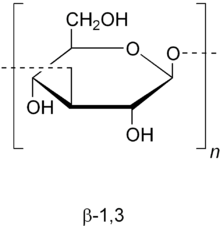Zymosan
Zymosan is a glucan with repeating glucose units connected by β-1,3-glycosidic linkages. It binds to TLR 2 and Dectin-1 (CLEC7A). Zymosan is a ligand found on the surface of fungi, like yeast. [1]
 | |
| Identifiers | |
|---|---|
| ChemSpider |
|
| ECHA InfoCard | 100.029.737 |
CompTox Dashboard (EPA) |
|
| Properties | |
| (C6H10O5)x | |
| Molar mass | Variable |
Except where otherwise noted, data are given for materials in their standard state (at 25 °C [77 °F], 100 kPa). | |
| Infobox references | |
Zymosan is prepared from yeast cell wall and consists of protein-carbohydrate complexes. It is used to induce experimental sterile inflammation. In macrophages, zymosan-induced responses include the induction of proinflammatory cytokines, arachidonate mobilization, protein phosphorylation, and inositol phosphate formation. Zymosan A also raises cyclin D2 levels suggesting a role for the latter in macrophage activation besides proliferation. It potentiates acute liver damage after galactosamine injection suggesting that certain types of nonparenchymal cells other than Kupffer cells are involved in zymosan action.[2]
References
- Sato M, Sano H, Iwaki D, et al. (2003). "Direct binding of Toll-like receptor 2 to zymosan, and zymosan-induced NF-kappa B activation and TNF-alpha secretion are down-regulated by lung collectin surfactant protein A". J. Immunol. 171 (1): 417–25. doi:10.4049/jimmunol.171.1.417. PMID 12817025.
- http://www.sigmaaldrich.com/catalog/search/ProductDetail/SIGMA/Z4250
External links
- Zymosan at the US National Library of Medicine Medical Subject Headings (MeSH)